How many of the Different Types of Mangoes have you tasted? Find out about the World’s Best Mango Varieties with us!
There’s a reason why mango is called the king of fruits! Its juicy sweetness is truly delicious. Do you know how many varieties of mangoes are there? With over 1000 varieties, there’s a perfect mango for every taste bud. Let’s see some of the most popular mango varieties!
Different Types of Mangoes Across the World
1. Rainbow
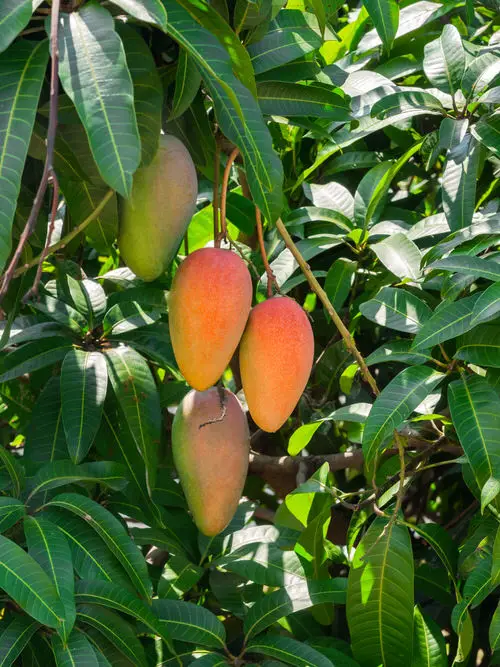
Flavor: Very sweet with a tropical fragrance
Flesh: Golden yellow in color and one flat seed
The Rainbow Mango is a delight that lives up to its name. It’s a hybrid variety created by combining the Thai Nam Doc Mai and the Indian Minh Chau varieties. Rainbow mangoes are also known for their exceptional flavor. They are juicy, very sweet, and have a lovely fragrance.
2. Honey (Ataulfo)
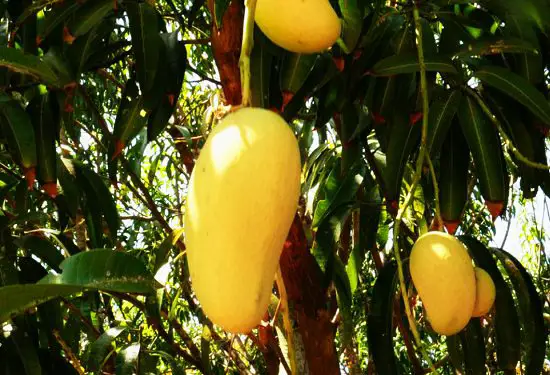
Flavor: Sweet and sour
Flesh: Peachy tropical aroma with smooth, firm flesh without fibers and a small pit
Ever tasted sunshine? Well, get ready because that’s what awaits you with a Honey Mango. This prized variety is known for its incredibly sweet and creamy flesh, making it a favorite among mango connoisseurs. We know what you’re thinking – with a name like Honey Mango, it must be really sweet, right? Well, you’re not wrong. Honey Mangoes are known for their sweetness, but they’re also balanced with a subtle tartness.
3. Francis

Flavor: Sweet and fruity
Flesh: Peach-like, tropical fragrance, and juicy, soft, fibrous flesh
The Francis mango is a delicious and popular mango variety that is known for its sweet and fruity flavor. It is one of the more common varieties available in the US, and it is mostly found from May to June. But the true magic lies in the flavor. Francis mangoes are known for their perfect balance of sweet and fruity.
4. Haden

Flavor: Sweet and sour with a mildly bitter after-taste
Flesh: Firm flesh with fruit-like aroma and medium fibers
Ah, the Haden mango – a true Floridian legend. This sunshine-colored fruit has a rich history and was one of Florida’s first commercially successful mango cultivars in 1902. Haden mangoes are known for their generous size, typically weighing in at a hefty 15 to 25 ounces each.
5. Keitt
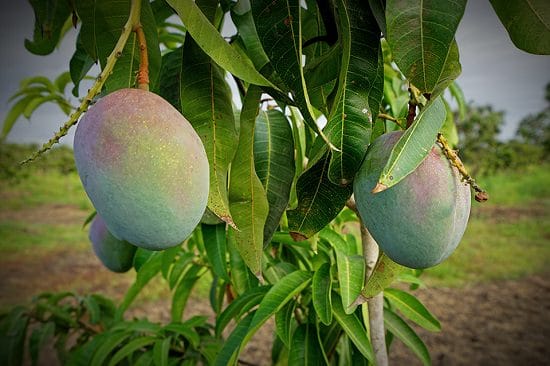
Flavor: Sweet and fruity
Flesh: Citrusy aroma and juicy, firm flesh, with little fiber
Keitt mangoes are popular with growers due to their large size, low fiber content, and consistent yield. They are also enjoyed in Asian cultures for their firm flesh, which can be eaten green or pickled. Plus, Keitt mangoes are a late-season treat and are available from July to September.
6. Kent

Flavor: Sweet with sour notes
Flesh: Tender, juicy flesh with limited fiber and tropical peachy aroma
The major countries that produce Kent Mangoes are Mexico, Ecuador, and Peru. This variety is ideal for juicing and drying and is available from December to February. When the fruit starts to ripen, yellow dots cover its skin. The peak season is in December, January, and February, so Kent mangoes are a welcome taste during the colder months.
7. Tommy Atkins

Flavor: Tart with sweet notes
Flesh: Citrusy fragrance and firm fibrous flesh
The Tommy Atkins mango might not be the flashiest fruit at the party, but it’s a reliable crowd-pleaser. It is native to Florida and is the most extensively grown variety in the United States. You can relish this delicious mango from March to July. Plus, it has a long shelf life.
8. Graham
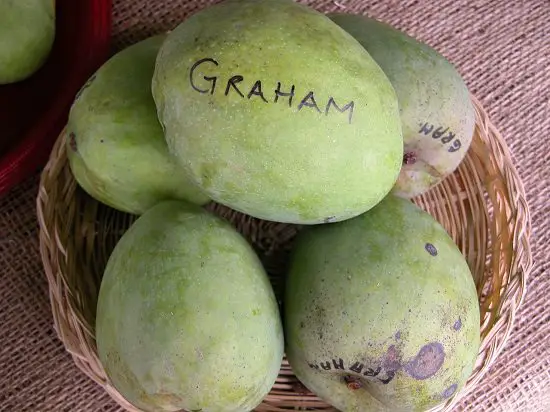
Flavor: Sweet
Flesh: Aromatic orange-colored, fiberless flesh
The Graham mango is a named mango cultivar that originated in Trinidad. It was introduced to the United States by the USDA through Florida in 1932 and has become a popular nursery stock tree in the city for home growing due to its fine flavor and good disease resistance.
9. Irwin
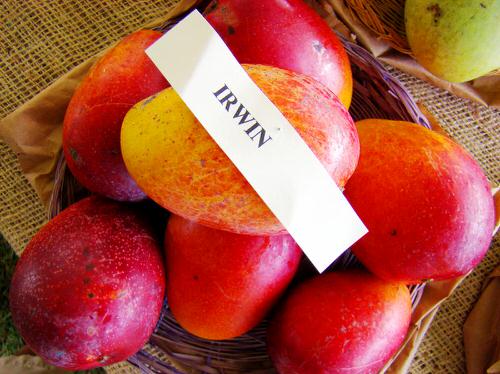
Flavor: Sweet
Flesh: Deep yellow flesh with red skin
Irwin is often called the Apple Mango because of its apple-like flavor. It is also grown in Japan, Central America, Taiwan, and Australia. Irwin has a delicious yellow flesh that is sweet when wholly ripened. One of the best things about Irwin mangoes is their lack of fiber – you can savor every delicious bite without any stringy interruptions.
10. Palmer
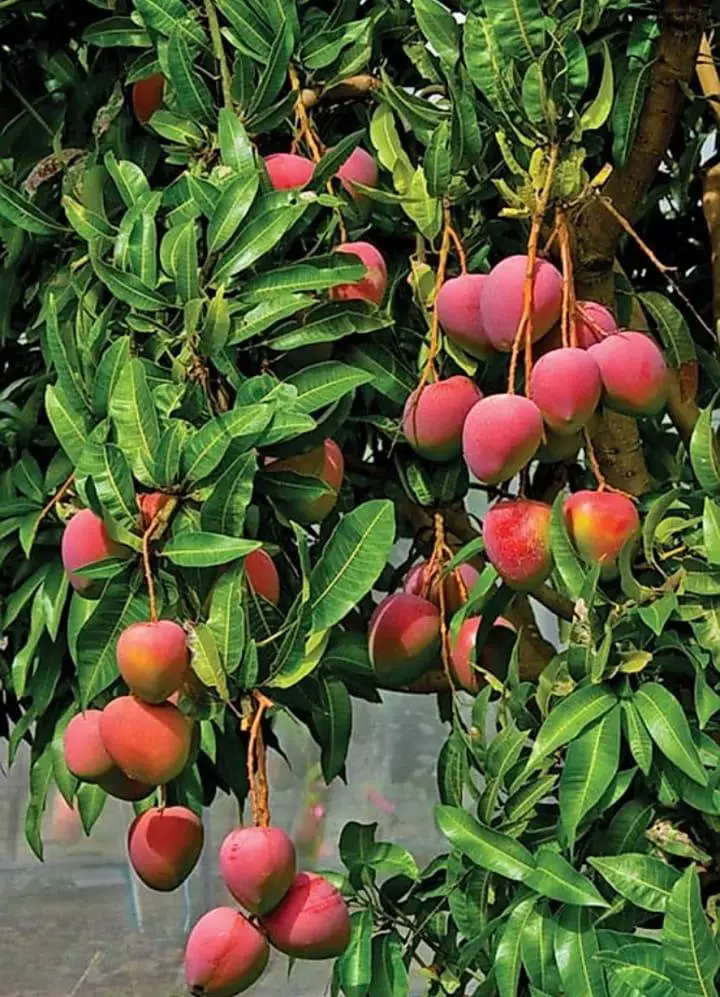
Flavor: Sweet and juicy
Flesh: Orange-yellow smooth flesh with few fibers
The Palmer mango is a large, commercially grown late-season mango cultivar that originated in South Florida. They are popular for fresh eating due to their sweetness and minimal fiber. You can use these in juices, smoothies, and salads.
11. Valencia Pride

Flavor: Sweet and juicy
Flesh: Fiberless, smooth, yellow flesh
Valencia Pride mangoes grow in California and Florida and can be an excellent example of large, long, oval-shaped fruit. The large fruit is covered with yellow-colored skin and has a reddish tint. But their looks are just the beginning. Valencia Pride mangoes are known for their wonderful sweetness and aroma.
12. Kensington Pride

Flavor: Sweet
Flesh: Yellow flesh with yellow-green skin
The Kensington Pride is also called the Bowen Mango, and this Australian variety is one of the most popular in the world. With yellowish-green skin, Kensington can also develop some red blushing on the skin. These Australian favorites typically reach peak season between September and February. They’re also easy to grow.
13. Glenn

Flavor: Sweet & Juicy
Flesh: Fiberless yellow flesh with an orange-tinged thin skin
The Glenn mango is a Floridian cultivar known for its good looks and delicious taste. It originated from a Saigon mango seed planted in 1940 and bears medium-sized, oval fruit with an orange-red hue. But the best part might be the flavor. Glenn mangoes are known for their sweetness, balanced with a hint of tartness.
14. Sein Ta Lone
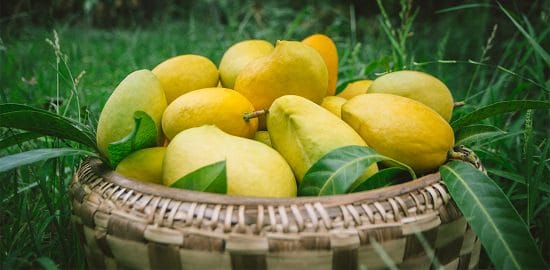
Flavor: Sweet
Flesh: Fruity aroma, juicy, and a less fibrous texture.
Sein La Tones are rare. These delightful mangoes are becoming increasingly popular outside of Myanmar and can be found in specialty stores or online retailers in countries like the United States and India. It is also known as the “Diamond Mango” or simply “Diamond.”
Different Types of Mangoes in India
Mangoes originated in India and its neighboring countries. If you do visit, don’t forget to try the following Indian mango varieties.
15. Alphonso
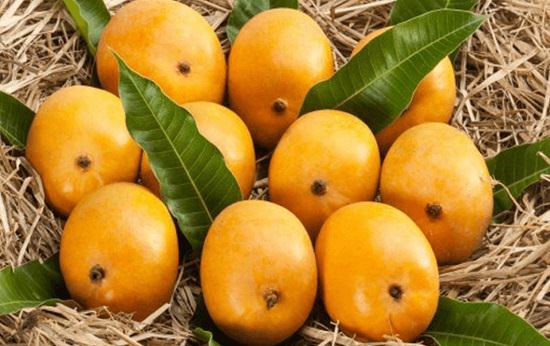
Flavor: Sugary-sweet
Flesh: Buttery, tender texture with no fiber
Of the numerous mango species around the world, Alphonso is surely the number one in taste and flavor. The main producer of this delightful variety in India is Maharashtra. They’re considered a premium fruit, so expect them to be a bit more expensive than other mangoes. But trust us, that first bite will be worth it!
16. Kesar
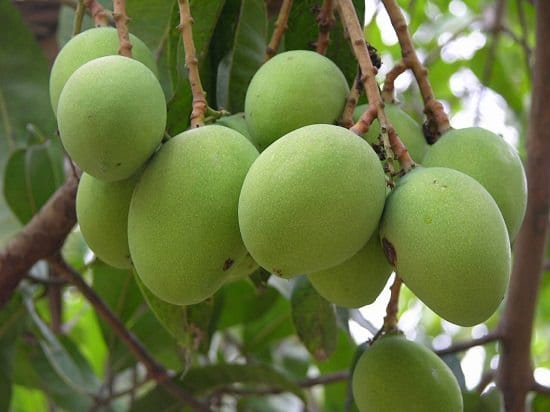
Flavor: Sweet
Flesh: Smooth and soft with no fiber
Kesar ranks second as the largest export variety of mangoes in India. It is grown in Girnar hill of Gujrat, India, and is available from May to July. They have a distinct saffron or yellowish-orange colored skin with a slight greenish tinge. And the flesh inside is bright orange.
17. Dasheri
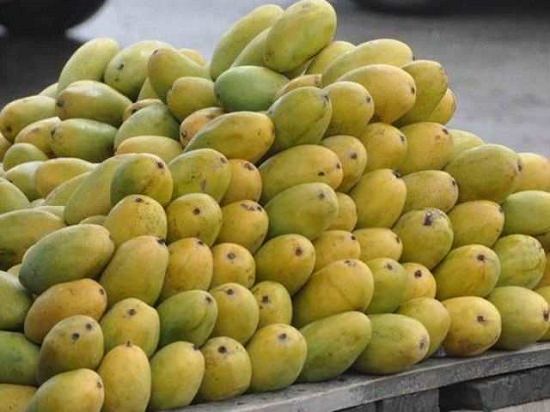
Flavor: Sweet and aromatic
Flesh: Fiberless, peach-colored pulp
Dasheri mangoes are available from mid-May to late August. It is long and oval-shaped, with yellow-green skin when ripe. Lucknow is the highest producer of this variety. They are enjoyed fresh, but their sweetness makes them great for desserts, jams, chutneys, and pickles.
18. Chausa
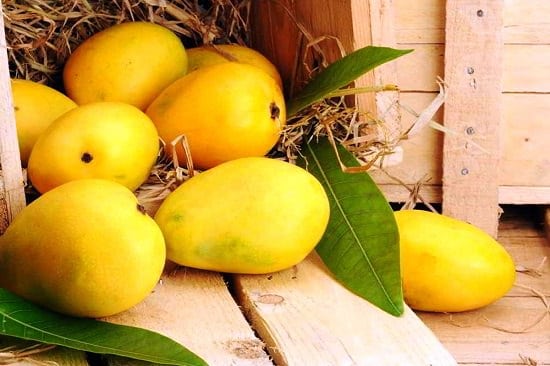
Flavor: Sweet
Flesh: Deep yellow luscious pulp with little fiber
The Chausa mango (also spelled Chaunsa) is a mango cultivar indigenous to South Asia, particularly favored for its rich flavor, texture, and high nutritional value. It is primarily grown in India and Pakistan. The Chaunsa season starts at the beginning of June and ends in the third week of August.
19. Bombay Green
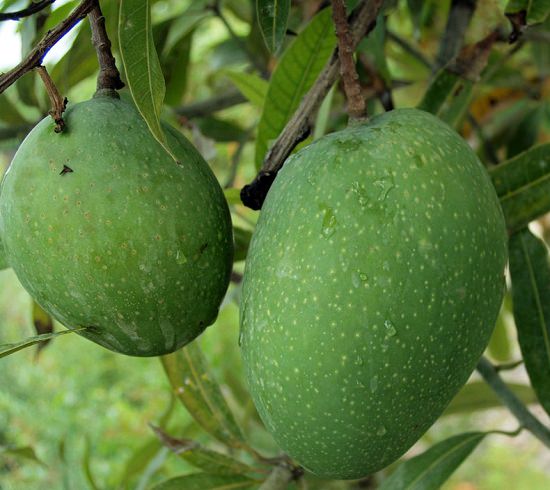
Flavor: Sweet
Flesh: Hard pulp with little to no fiber
Bombay Green is known for its sweet taste, green color, and versatility in consumption. They are enjoyed ripe for their sweetness or can be pickled while unripe for a tangy flavor. It originated from a seed brought to Jamaica from India during the Indian indenture system in the 19th century.
20. Langra

Flavor: Sweet
Flesh: Juicy fiberless pulp rich in fibers
The Langra mango is a lovely variety that boasts a rich history dating back 250 to 300 years. It was first cultivated in Banaras, present-day Uttar Pradesh, India. Apart from Uttar Pradesh, Langra mangoes are also grown in the states of Bihar and West Bengal, and in Bangladesh.
21. Amrapali
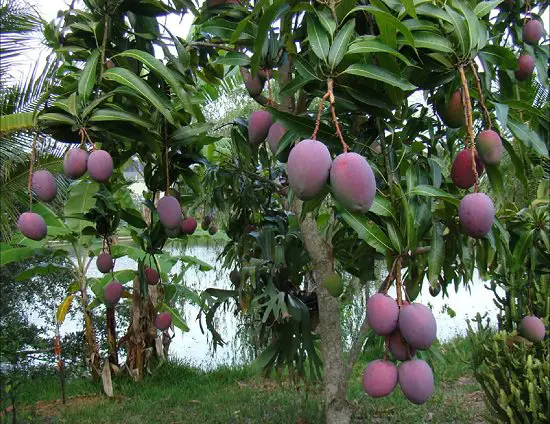
Flavor: Sweet
Flesh: Deep orange-red flesh with medium fibers
Amrapali was developed as a hybrid variety of ‘Dasheri’ and ‘Neelum’ by Dr. Pijush Kanti Majumdar at the Indian Agriculture Research Institute in Delhi. People grow it all over India, on farms and orchards.
22. Neelam
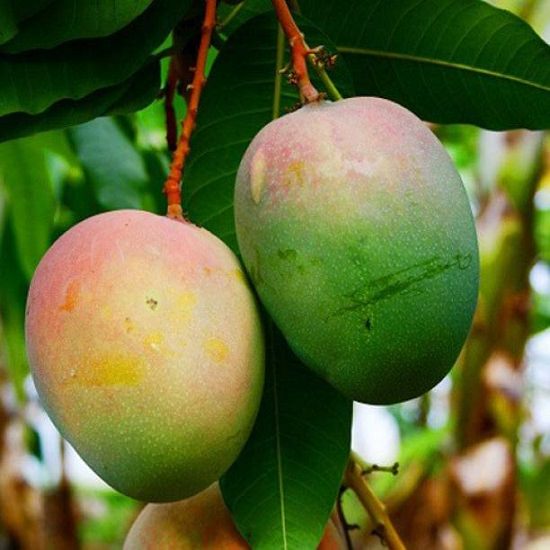
Flavor: Sweet
Flesh: Juicy and semi-hard with no fibers
Neelam mangoes are available throughout the season. Though the tastiest ones come in the month of June when monsoons occur. They are highly relished by mango fans across India but are primarily grown in Andhra Pradesh, Karnataka, and Tamil Nadu.
23. Banganpalli/Safeda

Flavor: Sweet and sour
Flesh: Fiberless, firm, yellow flesh.
The Banganapalli mango is a prized variety named after the town of Banganapalle in the Nandyal district of Andhra Pradesh, India. It is considered a premium variety due to its sweetness, minimal fibers, and juicy flesh.
24. Chok Anan
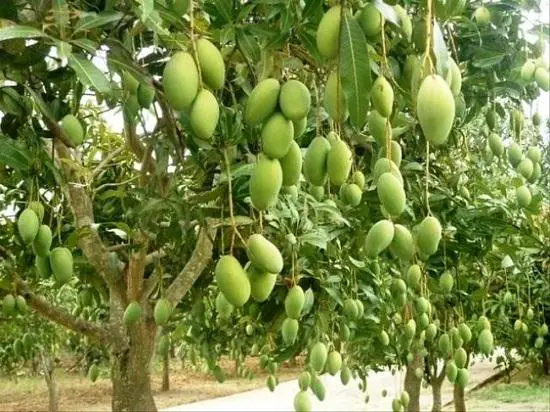
Flavor: Sweet
Flesh: Hard, yellow-colored with medium to no fiber
The Chok Anan mango is known for its large size, oval shape with tapered tips, and flavor. It is firm, juicy, and has very few fibers. They are nicknamed the “Miracle Mango,” as they produce two harvests a year – once in the summer and again in the winter.
25. Badam Mango
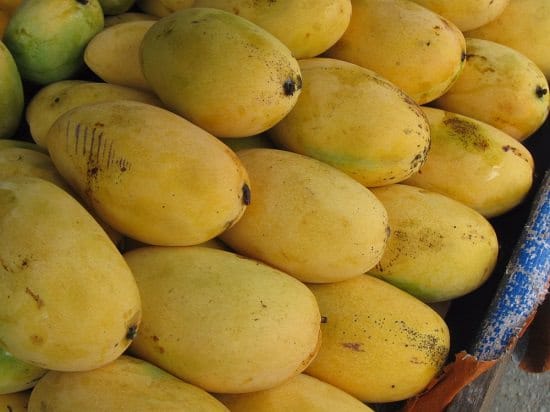
Flavor: Sweet
Flesh: Hard, juicy, yellow-colored with no fiber
The Badam mango is a delicious Indian variety known for its sweetness and resemblance to the Alphonso mango. These mangoes have a pale yellow, thin skin and a light yellow, juicy flesh. They are known for their intense sweetness and smooth, almost fiberless texture.
26. Totapuri
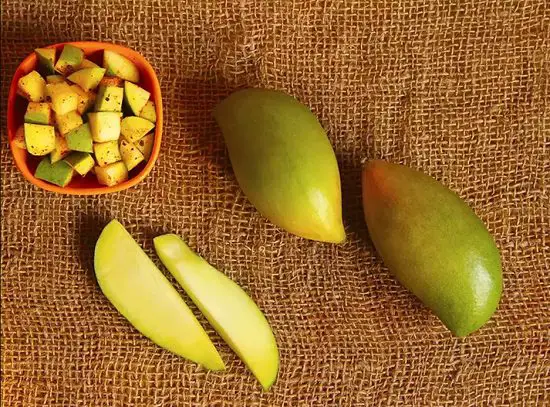
Flavor: Sweet and sour
Flesh: Hard, with no fiber
The Totapuri mango is a popular Indian variety known for its versatility. It has a greenish-yellow skin and tart, juicy flesh. Unlike other mangoes, Totapuri can be enjoyed even when unripe with a sprinkle of salt and chili powder.
27. Sindhri

Flavor: Very Sweet
Flesh: Deep yellow thin skin
Sindhri mangoes are the “King of Mangoes” in Pakistan and come from the Sindh province. They’re really sweet and give off a lovely scent. Sindhri mangoes are large-sized and easily grow around 6-8 inches.
28. Raspuri
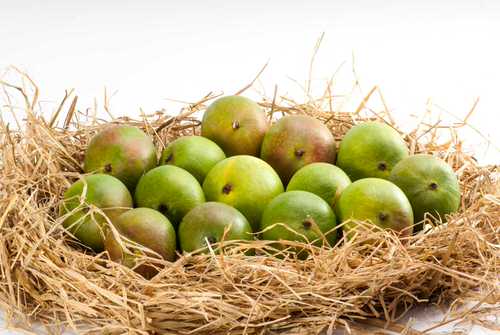
Flavor: Warm sweet taste, can also be pleasantly tart sometimes
Flesh: Bright yellow sweet flesh with yellowish-red skin
Raspuri is mainly cultivated and eaten in the Old Mysuru of Karnataka. It is oval and tastes excellent in smoothies, jams, and yogurts. You’ll also find it growing in and around Bengaluru, Ramanagara, Kolar, Chikkaballapura, and Tumakuru.
29. Anwar Ratol

Flavor: Pleasantly sweet
Flesh: yellow flesh with a firm and smooth pulp
Anwar Ratol is native to northern India, Nepal, and Pakistan. It is famous for its incredible silky textures. It is cultivated in the Punjab and Sindh regions of Pakistan and near the village of Rataul in Uttar Pradesh, India, earning it the name.
30. Himsagar
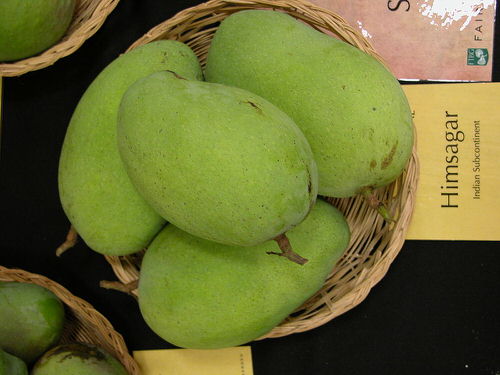
Flavor: Sweet
Flesh: Greenish flesh with yellow, creamy pulp
Himsagar is a sweet variety of Orissa and West Bengal, usually weighing around 250-350 gm. It is mainly used to make shakes and desserts. You can easily identify them as they have a golden yellow rind with a red tinge when ripe and a bright yellow pulp.
31. Malgoba
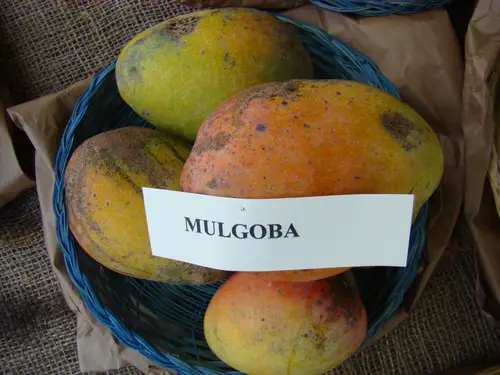
Flavor: Juicy and fragrant
Flesh: Light yellow with a tiny seed inside
The Malgoba is a green mango that is delicious and quite versatile. You can enjoy it fresh for its sweetness or pickle it while unripe for a tangy taste. It’s also commonly used in yummy curries and chutneys.
32. Pairi / Paheri
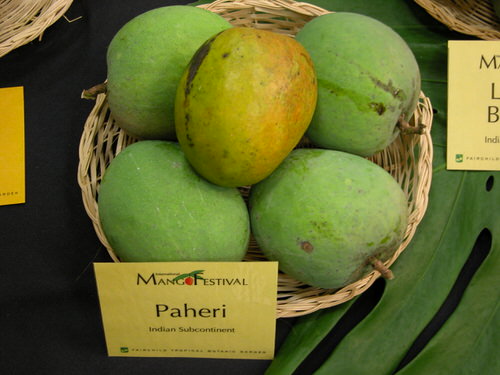
Flavor: Sweet and sour and incredibly juicy
Flesh: Fiberless bright yellow-colored smooth flesh
The Paheri mango is a hidden gem amongst mango varieties, known for its unique taste and limited availability. It’s a seasonal treat, typically found in the Saharanpur district of India during the summer.
33. Lakshmanbhog
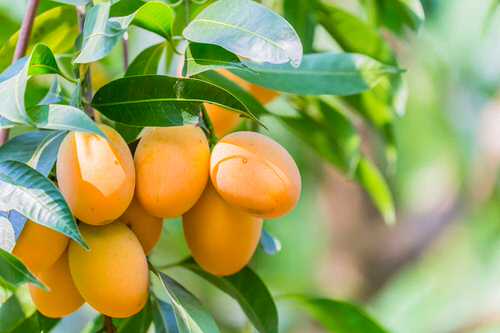
Flavor: Sweet and juicy
Flesh: Yellow-orange firm juicy pulp with yellow-orangish skin
Lakshmanbhog is exclusively cultivated in West Bengal and is available in June and July. It gets exported to the United States of America from India every year, so you can find it online or in local stores.
34. Fazli
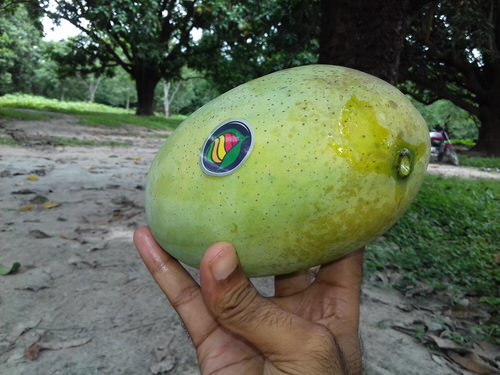
Flavor: Sweet and juicy
Flesh: Light yellow, firm yet juicy, with a pleasant fragrance
Fazli is also known for its comparatively larger fruits than other mango varieties that are filled with lots of pulp. Each Fazli mango weighs above a kilo and stands out for its exceptionally sweet taste. It is undoubtedly one of the biggest mango varieties you can find.
35. Imam Pasand

Flavor: Unique after-taste and incredibly sweet, juicy flavor
Flesh: Fibreless, creamy, soft pulp inside its thick skin
Imam Pasand is also a great mango that you must not miss. It has a unique sweet and tangy flavor that makes it a favorite of Indian people. These are large mangoes, typically weighing around 500 to 750 grams each. They have spotted green skin when unripe, lightening to yellow-green as they ripen.
36. Mallika

Flavor: Exceptionally sweet
Flesh: High quality, fiberless, orange-colored flesh
While not as widely known as some other Indian mango varieties, Mallika mangoes are popular for their sweetness and juicy texture. They are typically enjoyed fresh but can also be used in juices, smoothies, or salads.
37. Mankurad

Flavor: Sweet, juicy, and pulpy
Flesh: Yellow, firm pulp with a tiny seed
Mankurad is found in Goa, and this mid-season fruit is naturally sweet with very few fibers. Some people say it’s even sweeter than the famous Alphonso mangoes. Mankurad mangoes have a small, flat seed, so there’s more flesh you get to enjoy.
38. Vanraj
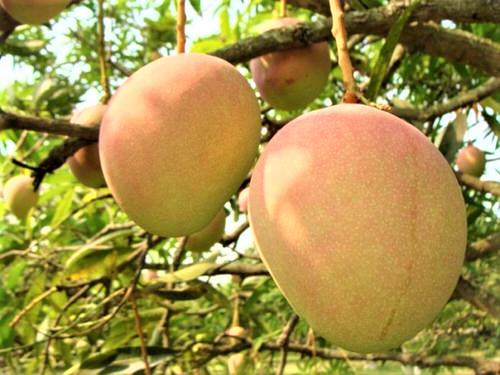
Flavor: Very sweet and sour and juicy
Flesh: Brilliant yellow
The Vanraj mango is a rare variety that is sought after in Gujarat, India, particularly in the city of Vadodara. These mangoes are known for their sweetness and juicy, deep yellow pulp. They have a lovely flavor and a soft texture. But they’re expensive, so you’ll have to spend quite a few bucks to afford them.
39. Gulab Khaas
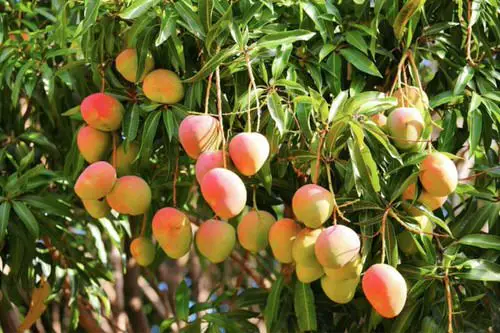
Flavor: Sweet
Flesh: Fiberless, Yellow, smooth flesh with red or pink skin
Gulab Khaas Mango has a rosy flavor that earns it the name. It is small and sold mainly in West Bengal, Bihar, and Jharkhand. It is a mid-season mango variety and is only available in the markets from May to June.
40. Kilichundan
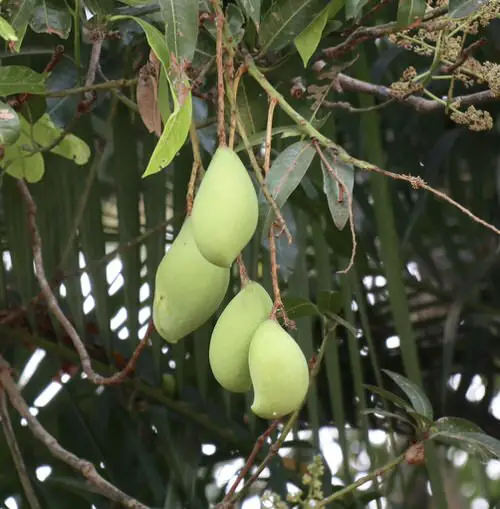
Flavor: Sweet and fragrant
Flesh: Greenish-yellow and smooth
Kilichundan mangoes are comparatively huge and are common in the southern states of India. It looks and means the ‘beak of a bird’ in Malayalam. These mangoes are medium-sized fruits with a greenish-yellow colored skin when unripe. As they ripen, the skin transforms into a beautiful golden-yellow color.
41. Rumani
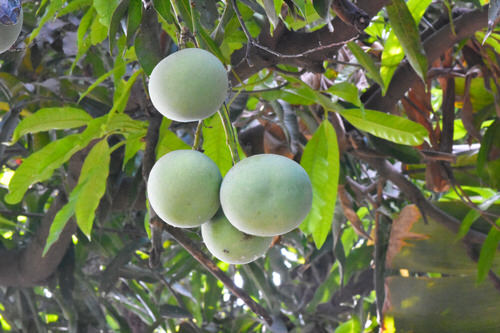
Flavor: Very sweet and juicy
Flesh: smooth flesh
The Rumani mango is a sweet and juicy type of mango grown mainly in North Andhra Pradesh, India. When ripe, the inside flesh is golden yellow, and it is very enjoyable to eat fresh. Rumani mangoes are known for their excellent flavor and are also called ice-cream mangoes.
Different Types of Mangoes in Thailand
42. Nam Dok Mai

Flavor: Sweet
Flesh: Thick and Fleshy
The Nam Dok Mai mango is a premium mango that comes from Thailand. They are excellent for eating fresh, but you can also use them in juices and smoothies because they have an intense flavor.
43. Khieo Sawoei Sampran

Flavor: Crunchy and Sweet
Flesh: Hard
The Khieo Sawoei Sampran mango is savored when it’s green and tart and not ripe. People enjoy it with a special dip made with fish sauce, sugar, and other ingredients. These are small oblong-shaped mangoes that turn a light yellow color when ripe.
44. Tong Dam

Flavor: Very Sweet
Flesh: Soft with fiber
The Tong Dam mango, also known as “Black Gold,” is also prized in Thailand. They are not that common but are sought after for their perfect combination of sweetness and smooth texture.
45. Mamuang Ok Rong
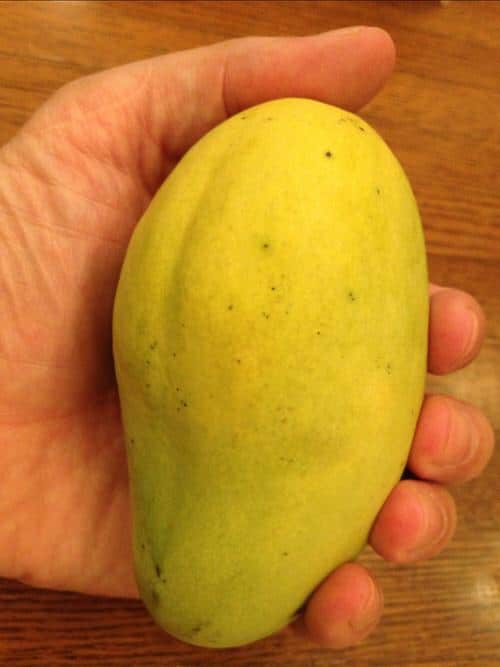
Flavor: Extremely Sweet
Flesh: Hard, with no fiber
Mamuang Ok Rong mangoes have a high demand because they’re used to make mango sticky rice–a famous Thai dessert. They are a prized possession for Thai farmers and a favorite among locals and tourists alike. But they are a bit on the expensive side.
46. Ivory
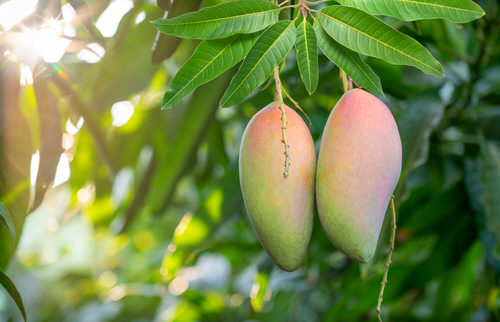
Flavor: Sweet
Flesh: Bright yellow-colored flesh and not too fibrous
Ivory Mangoes originated in Thailand but were introduced to China in 1914. Did you know that the tree that was the first to be imported from Thailand still grows today? Ivory mangoes are known for having very few fibers, with the flesh constituting approximately 82% of the fruit.
Different Types of Mangoes in Japan
47. Miyazaki – World’s Costliest Mango!

Flavor: Sweet and creamy
Flesh: Fiery red in color
The Miyazaki mango originated in California but was brought to Japan’s Miyazaki Prefecture, where it gets its name. Indian growers have also recently started growing this variety. In the international market, it is available at $3,100 – $3,700 per kilogram.
Different Types of Mangoes in the Philippines
48. Carabao
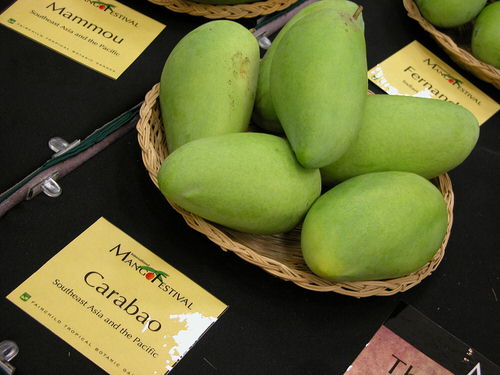
Flavor: Very sweet, juicy, and aromatic
Flesh: Tender melting consistency and rich yellow
The Carabao Mango, also called the Manila or Philippine Mango, is recognized as the world’s sweetest mango from the Philippines. It’s famous for its sweetness and exotic taste, and it even held the title of the sweetest mango in the world in 1995.
49. Pico/Piko or Padero
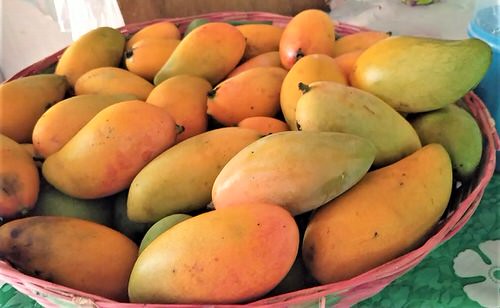
Flavor: Sweet
Flesh: Soft, creamy, pale yellow in color
Padero or Pico is one of the most commonly grown varieties of mango in the Philippines. The flesh of ripe fruits is a rich orange color that usually turns reddish near the tips. It’s soft but not as soft as Carabao mangoes.
50. Pahutan/Pajo

Flavor: Sweet
Flesh: Yellow and pulpy
Pahutan mangoes, unlike the Pico or Carabao, are not so common commercially and are known to be grown in the wild. They’re native to the Philippines and surrounding regions in Indonesia, Malaysia, Papua New Guinea, and the Solomon Islands.
51. Katchamita
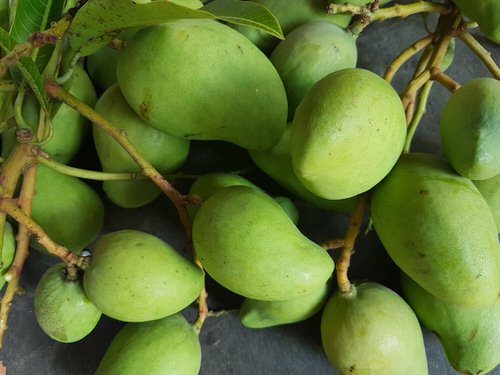
Flavor: Sweet and sour
Flesh: Green skin with firm, yellow flesh
Katchamita is also called the Indian mango because it comes from the peninsula. They are now common in the Philippines, and Filipinos often prefer them green when they have a pleasant tartness to their sweetness. As they ripen, the sweetness increases, and they become softer.
Different Types of Mangoes in Jamaica
52. Number Eleven
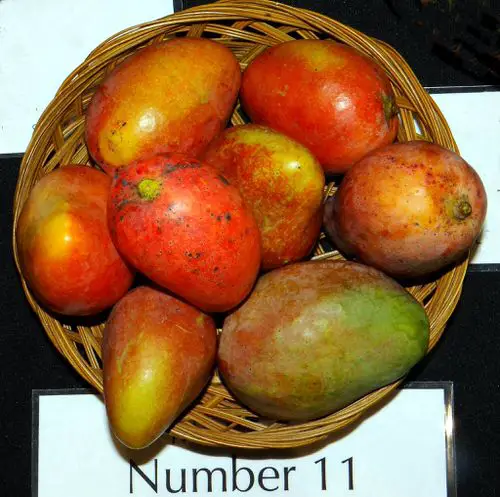
Flavor: Pleasantly aromatic and sweet
Flesh: Yellow and firm
Although Number Eleven mango is not meant for everybody, it is extremely popular for its unique flavor and shape. The fruit tastes remarkably tangy towards the seed. Number Eleven mango lovers prefer to ‘juice’ the mango.
53. Black/Blackie

Flavor: Very sweet
Flesh: Edible skin and covered in black spots with green or yellow flesh
This sweet mango variety is commonly known as Blackie and is popular because it is smaller than the common mangoes but not less sweet. The skin is edible, although it is susceptible to black spots.
54. Julie
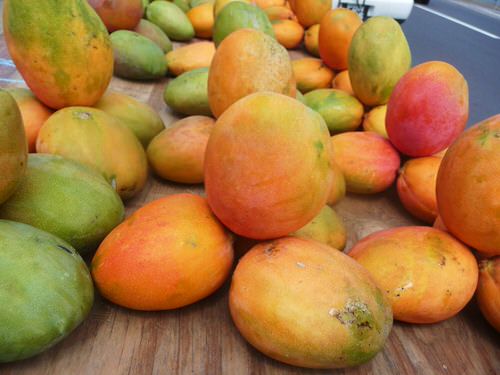
Flavor: Sweet and juicy
Flesh: Non-fibrous and deep orange color
Jamaicans most love Julie or St. Julian for its rich taste and smooth texture. It is not so colorful and can be found in green to a reddish-orange shade when ripened. Julie is round with a flat side and can be eaten when it is about to ripen.
55. East Indian

Flavor: Sharply sweet and juicy
Flesh: Fleshy and yellow
The East Indian mango is loved by most mango fans and is believed to be the topper in terms of class. As the name indicates, this variety was brought to the islands by laborers from India in 1845.



Chausa should be. # 1, there is mango even close to its taste.
Absolutely right you are ..
WOWI never knew there were so many types of mangos Thank You for sharing
Haven’t tried that. I don’t think it’s available in the US. The best you can get here is the Manila/Carabao. It’s not the best but it’s good.
carabao is the best. ask any westerner.
Carabao mango may be the sweetest but according to many mango connoisseur Alphonso is the world standard with its complex taste.
they’re all good
it’s not a competition
🌿
No, they are not all good. The ones that have a lot of fiber are not very good, IMO. I like the Carrie, M4 and Coconut Cream the best. The ones in the store are not good at all. I never even knew I liked mangoes until moving to Florida.. now I am trying to grow my own.
Oh it’s a competition! And Kesar is no.1 , followed by either Alphonso or Badami!
You can’t touch Indian mangoes, no time to be eating Carapoopsies.
Mankurad has been No 1 and shall remain so, my open challenge anyone in this universe,
those who have not seen,heard or tasted yet to ascertain same with a statement that all these mangoes are not to match a callibre of Mankurad even 0.1% , so now you can imagineg guys
But where would we find it?
Never heard of it. Where can we get it ? your email cont, please.
followed by Alphonso on second position
I hear that Alphanso is not very productive.
Nam Doc Mai is the best mango I’ve eaten.
Badami is good but Mallika is very sweet.
It is all depending of cutivation & soil.
Kolor of karnataka is good for manogos.
Like wise konkan of Maharasta for Alphonso.
I have not tried some of these varieties. So far my favorite in Florida is the Carrie. Hard to find
Consumers,
The “Rainbow” mango is the best tasting mango available….it will become more popular as soon as it gets more exposure to the U.S. Mangoes are very excellent tasting fruit which most people are not aware of. The previous varieties such as Tommy Atkins are not as edible as the new varieties that coming on now. The Tommy Atkins looked decent, shipped well, and had excellent production for the growers but that where it stopped as far as advantages. Be patient, the Rainbow, Coconut Cream, Honey Kiss, and Lemon Zest mangoes are to be available soon. The mango for informational purposes, is the most consumed fruits in all the world, it retains almost 40% of world fruit consumption. Appreciate the contact with the readers.
Alphonso mangoes are maybe marketed well but reality is atleast in India there is no match for Kesar. Must try and compare yourself.
The Cuban bizcochuelo is one of the best for me. Grew up eating them. It is not mentioned. Have my own tree in south Florida.
I tasted my first mango 20 years ago: it was disgusting! Yellow one. Probably wrinkly. I never ate a mango until recently it was meh and expensive. I bought another from the Mexican market (cheap) red mangoes and THE BEST IN THE WORLD!!! So yes, it IS a competition. Some are really sour and tasteless and not sweet. They should be EXTINCT! Why aren’t red mangoes from MEXICO here?? They’re the best! (And why are Haden, Kent and Neelam different varieties? They all look the same with little red.)
Yes RED mangoes from MEXICO are the best. Sweet,juicy and fiberless with a good shape.
Nam Dok Mai and Ok Rong are the best mangoes. Super sweet!!!
every mango is rich in vitamins. i love all of them. especially the sour varieties.
Khieo Sawoei, a Thai mango, the best mango in the the world that you can try – so Pranee, my student, tells me!
Carabao mango is the sweetest mango in the world. Search it, it’s a fact. And should by #1 mango by its taste, shape and color.
Of course – it’s subjective – different people have different tastes – but the best I’ve tasted is the Rabaul mango in Papua New Guinea. I think it might be similar to or the same as the varieties known as Cedar Bay or mangga golek
Really i love Anwar Atol and sindhri with chunsa mangoes of sindh Pakistan sweet and pleasant taste and excellent and charming smell
Which is the most cold hardy?
Have tried over 50 different varieties as I import fruit. Chaunsa from Pakistan is the best hands down!
ble to mail me some of the larger mangoes available like 4 to 5 pounds each
Believe the big ones are among: MULGOBA-KEIITT-FAZLI hope you get some of them for me.Live in Pinellas County,Florida.
ble to mail me some of the larger mangoes available like 4 to 5 pounds eachMy address 9353 120 St.Seminole,Fl.33772Hope you understand don’t know to much computers.Mike
Africa mangoes is not mention.
I have several mango trees in my backyard. Can’t tell the difference between leaves, they all look the same to me. They were all just thrown in my compost bend. With 14 trees, they all should be great. Planted with Love. Happy Gardening, most of all SHARING.
Thank you for this information. You say that Number 11 is not for everybody. Why is that? We have a local mango here that is very fibrous and I don’t like it at all. Someone just gave us 2 number 11 to plant in our garden, I want to make sure they are good mangos.
#11 is an excellent mango. Wish I had a tree
Wow, everyone is so passionate about their favorite. I will eat most any Mango, but do not like the fiber in some that I have had. How about, you all send me fresh mangos in refrigerated boxes so I can try them all. LOL
Yellow Angel is the best mango inthe world .Yellow coloured non fibrous had fleshy mango.
Kensington Pride mangoes are awesome, a bit unfortunate that they’re nowhere on this list
If I did a blind fold test and let most people try 10 different mangoes that were all low fiber. Few would be able to tell me what they are eating
Where is “White Chounsa” ? It should be no.1.
No Chaunsa? I throw this list right out,
I have two mango trees in my central Florida yard but I don’t know the variety. Fist sized, green – turn slightly reddish yellow when ripe with LOTS of fibers. Very sweet but not sure if I’m using at the proper time – they get very soft very fast. Would love to learn more.
We are leading Hydraulic and Pneumatic Components Supplier in Saudi Arabia. we’re the supplier of Accumulators, Valves, Pumps, Switches, filters
Do you have pictures of the variety of mangoes in Trinidad. I am reminded of the zabico mango variety which grew in my backyard and have not seen in many years..